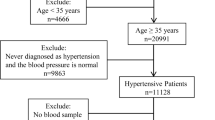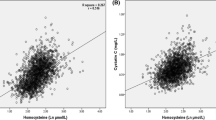Abstract
Background
Hyperhomocysteinemia (hyper-Hcy) is an important and reversible cardiovascular disease risk factor. We examined the prevalence of hyper-Hcy, plasma folate levels, and dietary folate intake in adolescents and young adults who had undergone kidney transplantation during childhood to assess the necessity for managing dietary folate.
Methods
This cross-sectional study was performed in 89 kidney transplant recipients (age at kidney transplantation: 12.6 ± 4.1 years; age during study: 21.2 ± 5.5 years). Hyper-Hcy and plasma folate deficiency were defined as plasma homocysteine (Hcy) >15 nmol/ml and plasma folate <3.0 ng/ml, respectively.
Results
Of the patients, 60 (67.4 %) had hyper-Hcy and 14 (15.7 %) had plasma folate deficiency. Plasma homocysteine levels correlated negatively with estimated glomerular filtration rate (eGFR; r = −0.565, p < 0.01) and plasma folate levels (r = −0.434, p < 0.01). For determinants of plasma homocysteine levels, a priori selected variables included kind of calcineurin inhibitor, age at kidney transplantation, pretransplant duration of dialysis, time since transplantation, age at examination, eGFR, and plasma folate. Stepwise multiple linear regression analysis revealed eGFR and plasma folate levels as significant independent variables influencing plasma homocysteine levels. Dietary folate intake in 11 of 16 patients (66.8 %) with eGFR ≥60 ml/min/1.73 m2 was below the recommended dietary allowance for Japanese.
Conclusions
The prevalence of hyper-Hcy and plasma folate deficiency, as well as the low dietary folate intake, suggest that dietary management of folate is necessary for adolescents and young adults who have undergone kidney transplantation during childhood.




Similar content being viewed by others
References
Liefeldt L, Budde K. Risk factors for cardiovascular disease in renal transplant recipients and strategies to minimize risk. Transplant Int. 2010;23:1191–204.
Dégi A, Kerti A, Kis E, Cseprekál O, Tory K, Szabó AJ, Reusz GS. Cardiovascular risk assessment in children following kidney transplantation. Pediatr Transplant. 2012;16:564–76.
Clarke R, Daly L, Robinson K, Naughten E, Cahalane S, Fowler B, Graham I. Hyperhomocysteinemia: an independent risk factor for vascular disease. N Engl J Med. 1991;324:1149–55.
Qin X, Huo Y, Langman CB, Hou F, Chen Y, Matossian D, Xu X, Wang X. Folic acid therapy and cardiovascular disease in ESRD or advanced chronic kidney disease: a meta-analysis. Clin J Am Soc Nephrol. 2011;6:482–8.
Friedman AN, Bostom AG, Selhub J, Levey AS, Rosenberg IH. The kidney and homocysteine metabolism. J Am Soc Nephrol. 2001;12:2181–9.
Winkelmayer WC, Kramar R, Curhan GC, Chandraker A, Endler G, Födinger M, Hörl WH, Sunder-Plassmann G. Fasting plasma total homocysteine levels and mortality and allograft loss in kidney transplant recipients: a prospective study. J Am Soc Nephrol. 2005;16:255–60.
Merouani A, Delvin EE, Genest J Jr, Rozen R, Lambert M. Plasma homocysteine concentration changes after renal transplantation in children. Pediatr Nephrol. 2002;17:520–3.
Matsuo S, Imai E, Horio M, Yasuda Y, Tomita K, Nitta K, Yamagata K, Tomino Y, Yokoyama H, Hishida A, Collaborators developing the Japanese equation for estimated GFR. Revised equations for estimated GFR from serum creatinine in Japan. Am J Kidney Dis. 2009;53:982–92.
Schwartz GJ, Brion LP, Spitzer A. The use of plasma creatinine concentration for estimating glomerular filtration rate in infants, children, and adolescents. Pediatr Clin North Am. 1987;34:571–90.
Menon V, Wang X, Greene T, Beck GJ, Kusek JW, Selhub J, Levey AS, Sarnak MJ. Homocysteine in chronic kidney disease: effect of low protein diet and repletion with B vitamins. Kidney Int. 2005;67:1539–46.
Shiraishi M, Haruna M, Matsuzaki M, Ota E, Murayama R, Murashima S. Association between the serum folate levels and tea consumption during pregnancy. Biosci Trends. 2010;4:225–30.
National Kidney Foundation. K/DOQI clinical practice guidelines for chronic kidney disease: evaluation, classification, and stratification. Am J Kidney Dis. 2002;39:S1–266.
Kazemi MB, Eshraghian K, Omrani GR, Lankarani KB, Hosseini E. Homocysteine level and coronary artery disease. Angiology. 2006;57:9–14.
Shane B. Folate status assessment history: implications for measurement of biomarkers in NHANES. Am J Clin Nutr. 2011;94:337S–42S.
Yoshimura Y, Kamada C, Takahashi K, Kaimoto T, Iimuro S, Ohashi Y, Araki A, Umegaki H, Sakurai T, Ito H; Japanese Elderly Diabetes Intervention Trial Study Group. Relations of nutritional intake to age, sex and body mass index in Japanese elderly patients with type 2 diabetes: the Japanese Elderly Diabetes Intervention Trial. Geriatr Gerontol Int. 2012; 12 Suppl 1:29–40. doi: 10.1111/j.1447-0594.2011.00810.x.
Ministry of Health, Labour and Welfare. Dietary Reference Intakes for Japanese (2010). 2009; 162–4 (In Japanese).
Goto S, Fujii H, Kim JI, Fukagawa M. Homocysteine and folic acid levels in hemodialysis patients treated with sevelamer hydrochloride. Clin Nephrol. 2010;73:420–5.
Becker-Cohen R, Nir A, Rinat C, Feinstein S, Algur N, Farber B, Frishberg Y. Risk factors for cardiovascular disease in children and young adults after renal transplantation. Clin J Am Soc Nephrol. 2006;1:1284–92.
Belson A, Sanchez J, Alexander SR, Salvatierra O, Dar MH, Reif S, Yorgin PD. Hyperhomocysteinemia in pediatric and young adult renal transplant recipients. Pediatr Transplant. 2004;8:161–6.
Sakuta H, Suzuki T, Yasuda H, Wakiyama H, Hase K. Plasma vitamin B12, folate and homocysteine levels in gastrectomized men. Clin Nutr. 2005;24:244–9.
Milne DB, Johnson LK, Mahalko JR, Sandstead HH. Folate status of adult males living in a metabolic unit: possible relationships with iron nutriture. Am J Clin Nutr. 1983;37:768–73.
Brouwer IA, van Dusseldorp M, West CE, Meyboom S, Thomas CM, Duran M, van het Hof KH, Eskes TK, Hautvast JG, Steegers-Theunissen RP. Dietary folate from vegetables and citrus fruit decreases plasma homocysteine concentrations in humans in a dietary controlled trial. J Nutr. 1999;129:1135–9.
Watanabe H, Ishida S, Konno Y, Matsumoto M, Nomachi S, Masaki K, Okayama H, Nagai Y. Impact of dietary folate intake on depressive symptoms in young women of reproductive age. J Midwifery Womens Health. 2012;57:43–8.
Acknowledgments
The authors gratefully acknowledge Drs. Noriko Sugawara and Kiyonobu Ishizuka (Department of Pediatric Nephrology, Tokyo Women’s Medical University, School of Medicine, Japan) for their research assistance.
Conflict of interest
The authors have declared that no conflict of interest exists.
Author information
Authors and Affiliations
Corresponding author
About this article
Cite this article
Hamatani, R., Otsu, M., Chikamoto, H. et al. Plasma homocysteine and folate levels and dietary folate intake in adolescents and young adults who underwent kidney transplantation during childhood. Clin Exp Nephrol 18, 151–156 (2014). https://doi.org/10.1007/s10157-013-0819-3
Received:
Accepted:
Published:
Issue Date:
DOI: https://doi.org/10.1007/s10157-013-0819-3




